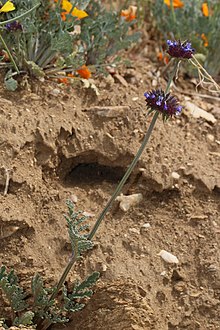bio.wikisort.org - Plant
Salvia columbariae is an annual plant that is commonly called chia, chia sage, golden chia, or desert chia, because its seeds are used in the same way as those of Salvia hispanica (chia). It grows in California, Nevada, Utah, Arizona, New Mexico, Sonora, and Baja California,[2] and was an important food for Native Americans. Some native names include pashiiy from Tongva and it'epeš from Ventureño.
Description

Salvia columbariae grows 10 to 50 cm (3.9 to 19.7 in) tall. Its stem hairs are generally short and sparse in distribution. It has oblong-ovate basal leaves that are 2 to 10 cm (0.79 to 3.94 in) long. The leaves are pinnately dissected and the lobes are irregularly rounded. The inflorescence is more or less scapose, meaning it has a long peduncle that comes from the ground level that has bracts. The bracts are round and awn-tipped. There are usually 1–2 cluster of flowers within the inflorescence. The calyx is 8 to 10 mm (0.31 to 0.39 in) long and the upper lip is unlobed but has 2 (sometimes 3) awns. The lower lip is about twice the size of the upper lip. The flower color can be pale blue to blue and purple tipped. The stamens of the plant are slightly exserted. The fruit of S. columbariae is a nutlet that is tan to grey in color and 1.5 to 2 mm (0.059 to 0.079 in) long.[1]
Varieties
- Salvia columbariae var. columbariae Benth. – California sage, chia
- Salvia columbariae var. ziegleri Munz – Ziegler's sage[3]
Habitat
Salvia columbariae can be found in dry undisturbed sites, chaparral, and coastal sage scrub. It generally grows at elevations lower than 2,500 m (8,200 ft). In cultivation, it prefers good drainage, sun, and dry weather.[1]
Uses
Medicinal uses
The Cahuilla used the columbariae Benth. variety as a disinfectant by grinding the seeds to mush and applying it to infections as a poultice.[4][5] The Cahuilla, Ohlone, Kawaiisu, and Mahuna used the gelatinous seeds to cleanse out foreign matter in the eyes. The seeds were placed in the eyes for infections and inflammation, and during sleep, they were tucked underneath the eyelids to remove sand particles.[5] The Ohlone also used it to reduce fevers by consuming the seeds, and the Diegueno chewed the seeds on journeys by foot to give strength.[5]
Food
The Cahuilla, Kawaiisu, Mohave, Tohono O'odham, Chumash and Akimel O'odham grind the seeds and mixed it into water to make a thick beverage. The Cahuillas removed the alkali salts in the water, improving the flavor. They also dry the seeds to make cakes or mush. The Ohlones, Mohave, and Pomo make pinole. The Diegueno added the seeds to wheat to improve flavor. The Mahuna, Paiute, and Akimel O'odham make it into a gelatinous material, then cook it into porridge. The Luiseno, Tubatulabal, and Yavapai used it extensively as a food source.[5]
Building material
The Mahuna made it into a fiber and covered their dwellings.[5]
References
- "Salvia columbariae". in Jepson Flora Project (eds.) Jepson eFlora. Jepson Herbarium; University of California, Berkeley. 2018. Retrieved 2018-07-06.
- Sullivan, Steven. K. (2018). "Salvia columbariae". Wildflower Search. Retrieved 2018-07-06.
- Salvia columbariae. ITIS.
- "Temalpakh Ethnobotanical Garden". malkimuseum.org. Archived from the original on 2008-05-15.
- "Salvia columbariae Benth". herb.umd.umich.edu.
External links
 Media related to Salvia columbariae at Wikimedia Commons
Media related to Salvia columbariae at Wikimedia Commons- Salvia columbariae in the CalPhotos photo database, University of California, Berkeley
- "Salvia columbariae". Calflora. Berkeley, California: The Calflora Database.
- "Salvia columbariae". Plants for a Future.
На других языках
- [en] Salvia columbariae
[fr] Salvia columbariae
Salvia columbariae, parfois appelée chia dorée ou chia du désert (à ne pas confondre avec la chia ou Salvia hispanica, de la même famille), est une espèce de plantes herbacées annuelles de la famille des Lamiaceae, qui pousse à l'état natif dans les zones arides du Sud-Ouest des États-Unis et du Nord du Mexique. Elle fait partie du genre Salvia, dont les membres sont communément appelés « sauges ». Ses akènes ont largement été utilisés par les populations amérindiennes comme source de nourriture et comme plante médicinale. Son nectar et ses akènes sont une source alimentaire appréciée également de la faune locale.Другой контент может иметь иную лицензию. Перед использованием материалов сайта WikiSort.org внимательно изучите правила лицензирования конкретных элементов наполнения сайта.
WikiSort.org - проект по пересортировке и дополнению контента Википедии

